IBM—华为PDM项目IBM_Internal_IT
PDM概念培训教材-华为、IBM、PTC的联合培训
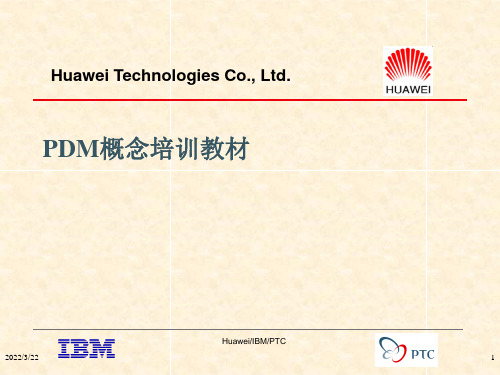
2022/3/22
13
Bring Them All Together
2022/3/22
14
PDM主要功能
文档管理
(Document Management)
FILE..LWP FILE..XLS /FILE.HTML
变更管理
(Change Management)
• 圈阅(Mark-up)指在不改变原文件的基础上,增加审阅人的意 见和修正功能。
• Windchill的万能浏览器产品为“ProductView”
2022/3/22
24
产品结构管理--内容
• 产品结构 • 部件和文档的关联 • 多视图管理 • 基线管理 • 有效性管理
2022/3/22
3 A
33 BC
Software Development
Configurator
2022/3/22
5
PDM,Not If,But When
PDM,缩短产品开发周期、降低产品开发成本、加速新产品开发
• 在产品设计的早期运作效率越高,就会在产品中注入 更强的功能;在产品设计的关键时期优化得越好,产 品就会越成功。
ECAD
1
2
1
2
1
2022/3/22
18
文档管理--检索
本地搜索:通过对象的属性条件来查询。如按作者、文档编号
、文档类型等查询,这些 条件可单独使用,也可联合使用。
2022/3/22
19
文档管理--检索
企业搜索:由搜索引擎支持,通过文档关键字进行查询,可以
针对文档的内容进行。如查找包含关键字“GSM”的文档等。
Project Management Product Development
IBM ODM 运营决策管理平台介绍及在保险行业的应用_2016

那么
3
<?xml version="1.0" encoding="UTF-8"?> <m:Transaction> <m:amount>20000.0</m:amount> <m:countryCode>111</m:countryCode> <m:creditCard>002</m:creditCard> <m:merchantType>2222</m:merchantType> <m:timestamp>2014-06-06T03:00:00</m:timestamp> <m:transactionCode>3333</m:transactionCode> <m:transactionId>0020003</m:transactionId> </m:Transaction>
业务流程、应用程序和解决方案
决策服务
环境决策管理 情景决策管理
业务规则作为 某个事务的特 定执行实例在 某个时间点触 发 相对静态
业务规则
持续洞察的事件处理
业务事件随时 间变化或与其 他活动相关联 相对动态
决策分析和模拟
内部和外部数据
业务事件及其特点
电话接入
业务事件是?
业务事件是一个广泛的概念,它几乎存在所有 的业务过程中,比如: 拨打95558进行业务咨询,在银行营业柜台 办理某业务,在ATM机操作…… 拨打10086进行业务咨询,在移动营业厅办 理某业务,修改服务密码……这些都是业务 事件,都带来了业务状态的改变.
华为PDM产品介绍

Solutions
主管和项目办 Agile Product Portfolio Management
综合产品、项目、资源及其组合管理
研发与工程
Agile Engineering Collaboration
产品和项目 满足法规规范和标准要求
工程应用集成与设计协 同
质量专员
Agile Product Service &
PDM的引入 PDM的概念 PDM主要功能 PDM实施策略 业界动态及展望
PDM的定义
PDM是一个方法论(methodology)和一整套帮助企业管理产品数据 和产品研发过程的工具(set of tools )。
——摘自CIMdata 《PDM buyer's guide》1999年
战略性商业方法
Doc01
CheckOut-
CheckIn
1
A Revise
B
2
3
1
2
研发文档
文档相关流程
一般文件审核流程 非设计、技术文档
直接提交流程 中研技术设计文档
发行 检视流程 评审流程
软件、 发 PCB文件、 行 电路图等
生产文件
直接提交流程 各类操作指导书
制造文档验证流程
试发 行
发行评审流程
生产 发行
PDM 解决 什么问题
? 数据共享程度低,数据源多
硬件开发与软件开发通常独立
硬件和软件配置未作为一个系统进行管理,导致产品 版本控制问题
产品变更未进行有效跟踪和控制,更改频繁
未实现以部件为中心的产品数据集成管理
…….
PDM 缩短产品开发周期、降低产品开发成本、加速新产品开发
华为与ibm
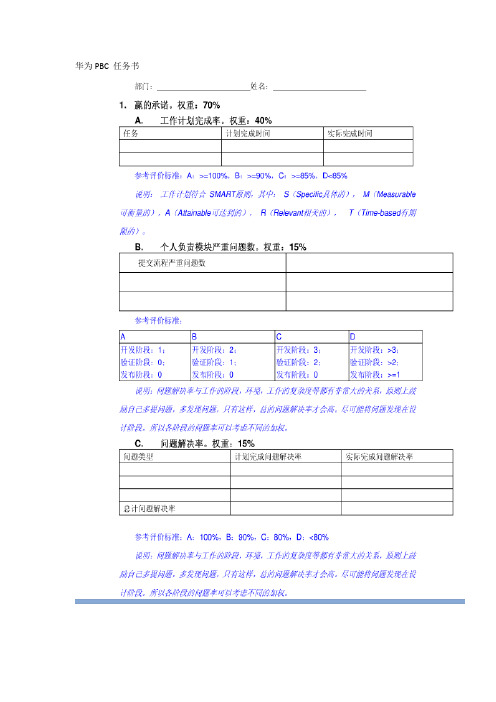
华为PBC 任务书IBM的PBC ——通透的绩效管理文化好的沟通渠道能够形成通达的企业氛围,人和企业制度达到互动,就会激发员工开动脑筋,改进工作,形成健康活泼的企业文化,这将从根本上保留一个企业的价值。
IBM的企业文化是尊重个人,追求卓越,激发员工的潜能,达到高绩效。
在IBM 公司里,谈起业绩考核,人们经常说的一句话是:“让业绩说话”(Performance Says)。
以PBC为中心的绩效考核体系IBM的绩效考核体系是以一个称为“个人业务承诺”(PBC,Personal Business Commitments)的项目为中心展开和运作的。
这个体系是建立在一系列绩效管理目标基础之上的,在这一点上与很多绩效管理优秀的跨国公司并没有什么不同(见图1)。
PBC是一个业绩管理系统,IBM的所有员工都要围绕“力争取胜、快速执行、团队精神”的价值观设定各自的“个人业务承诺”。
年初每个员工都要在充分理解公司的业绩目标和具体的KPI指标的基础上和在部门经理的指导下制订自己的PBC,并列举出在下一年中为了实现这些业绩目标、执行方案和团队合作这三个方面所需要采取的具体行动。
这相当于员工与公司签定了一个一年期的业绩合同。
PBC制订具体流程(见图2)。
个人业务承诺的制订是一个互动的过程,是通过员工个人与直属主管和经理不断的沟通过程中制定的,不是简单的任务分解和对上级命令的执行。
这种做法可以使员工个人的业务目标与整个部门的业绩目标相融合,进而与公司业务目标紧密结合,提高员工个人的参与感,落实每个岗位的责任并调动了员工工作的主动性,同时可以保证其目标得到切实的执行。
要想在PBC评分上取得好的等级,就必须清晰了解自己部门的业绩目标,抓住工作的中心,充分发挥团队合作优势,并强调切实执行。
这三个承诺具体细节如下:第一个承诺:承诺必胜(win),赢得市场地位,高效率运作,快速作出反应,准确无误的执行,发挥团队优势,取得有利形势。
这个承诺要求成员要抓住任何可以获取成功的机会,以坚强的意志来鼓励自己和团队,并且竭力完成如市场占有率、销售目标等重要的绩效评估指标。
IBM—华为PDM项目IT流程体系
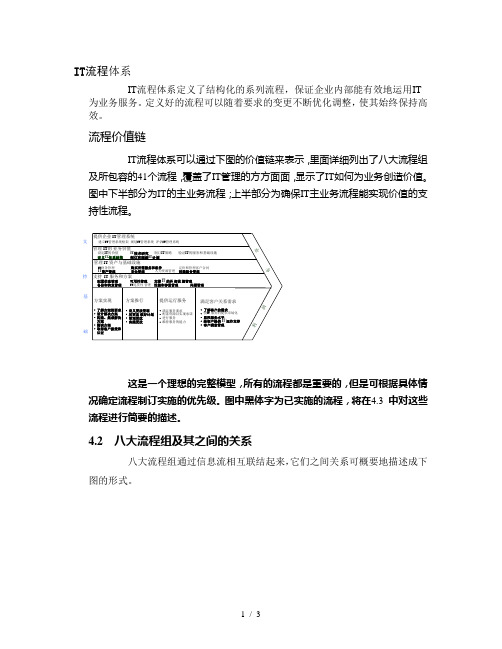
IT流程体系IT流程体系定义了结构化的系列流程,保证企业内部能有效地运用IT 为业务服务。
定义好的流程可以随着要求的变更不断优化调整,使其始终保持高效。
流程价值链IT流程体系可以通过下图的价值链来表示,里面详细列出了八大流程组及所包容的41个流程,覆盖了IT管理的方方面面,显示了IT如何为业务创造价值。
图中下半部分为IT的主业务流程;上半部分为确保IT主业务流程能实现价值的支持性流程。
这是一个理想的完整模型,所有的流程都是重要的,但是可根据具体情况确定流程制订实施的优先级。
图中黑体字为已实施的流程,将在4.3 中对这些流程进行简要的描述。
4.2 八大流程组及其之间的关系八大流程组通过信息流相互联结起来,它们之间关系可概要地描述成下图的形式。
“提供企业IT管理系统”流程组通过建立一个运作框架和受控环境,从而使运行其中的IT流程能实现其价值。
主要内容是根据企业战略与政策、市场信息、行业及技术趋势、业界最佳实践等,建立IT管理系统框架(如指导原则、影响因素、目标方向等)、规划IT管理系统(如管理模型、政策与计划、流程所有者、方法与实践等)并评估IT管理系统(如IT流程运作结果、关键指标测量、趋势分析等),然后对其进行调整。
“管理IT的业务价值”流程组通过制定IT策略、结构和规划,将公司业务策略与IT能力结合在一起,并根据客户需求对业务进行判断,以指导技术上的决策。
主要内容是建立IT价值(即确立IT的定位)、制定IT策略、调整IT输出与基础设施、制定并跟踪IT规划、进行技术研究、定义IT基础结构。
“方案实现”流程组是IT的“工程与制造”,应基于合理的用户需求,制定出完整的解决方案,并与用户就推行计划达成共识。
主要内容是了解方案需求、设计解决方案、构建或集成解决方案、测试方案、取得用户认可并通过用户验收。
“方案推行”流程组以对IT生产环境影响或破坏最小为原则,对变更进行管理、计划并实现;要根据用户或来自其它流程的需求,对变更过程提供完成的方案。
IBM—华为APS项目系统分析培训教材-200403
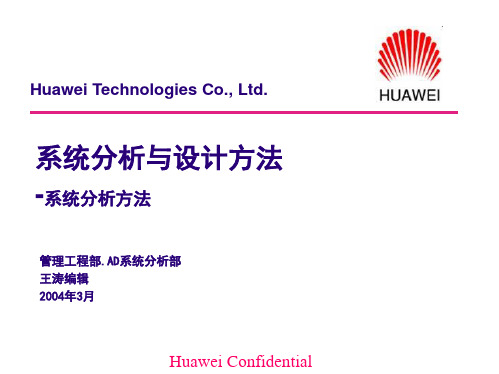
– 内部用户是构建信息系统的企业雇员。 – 外部用户是其他企业和外部客户
• 系统设计人员
– 设计系统来满足用户需求。在多数情况下,这些技术专家也是系统构造 人员,比如架构设计师等
– 基于Zachman框架的信息系统构件和信息系统开发生命周 期为主线
– 详细探讨了系统开发生命周期的前期、中期和后期活动以 及跨生命周期活动
– 重点是系统开发生命周期的前期和中期活动,即系统分析 和设计活动
华为保密资料,请勿外传
2
目录
• 系统分析和设计环境 • 系统分析方法 • 系统设计方法 • 系统分析和设计完成后的工作 • 面向对象分析与设计
– 尽管还,没有人抱怨,但可以改进现状的机会 – 无论是否有人抱怨,都要改变现状的指示。
• 解决方法的基本步骤
– 确定问题 – 分析并理解问题 – 确定对方案的需求或预期 – 确定可选的方案并决定行动计划 – 设计并实现“最好的”方案 – 评估结果。如果问题没有得到解决,则应该回到第一步或第二步。
• 系统分析员在哪儿工作
• 信息技术(IT)是一个现代词汇,描述计算机技 术(硬件和软件)和电信技术(数据、图像、 网络和语音)的组合
华为保密资料,请勿外传
5
系统分析和设计环境
• 系统参与者 • 信息系统构件 • 信息系统开发 • 项目管理
华为保密资料,请勿外传
6
信息系统的干系人是对某个已有(独立于技术的系统是什么和必须做什么)
信息系统的设计 (如何使用技术实现系统)
信息系统的构成 (系统实际的技术实现)
厂商和 咨询顾问
IBM—华为PDM项目Report Specifications
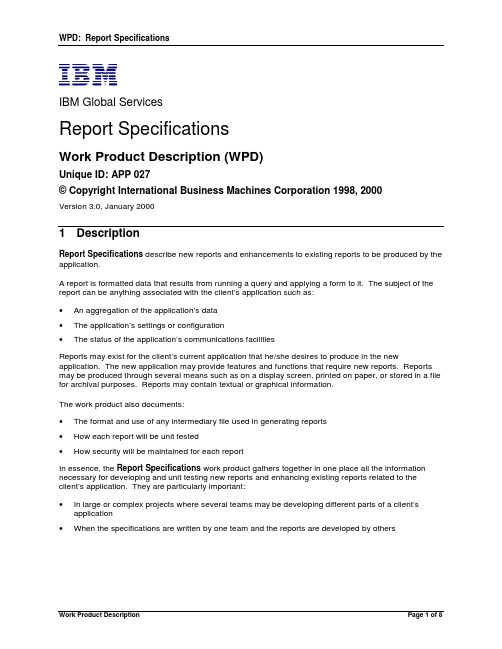
2.1 Impact of Not Having This Work Product
Not producing this work product presents several risks:
Version 3.0, January 2000
1 Description
Report Specifications describe new reports and enhancements to existing reports to be produced by the application.
application • When the specifications are written by one team and td by others
Work Product Description
Page 1 of 8
WPD: Report Specifications
WPD: Report Specifications
IBM Global Services
Report Specifications
Work Product Description (WPD)
Unique ID: APP 027 © Copyright International Business Machines Corporation 1998, 2000
• Provide the development teams with the details to develop and unit test each report The work product is also use to:
• Provide a consistent communications vehicle among the development teams that have responsibility for developing the various programs comprising the client’s application. The format of the reports should be consistent regardless of which part of the application produces a report.
IBM—华为PDM项目User Support Materials
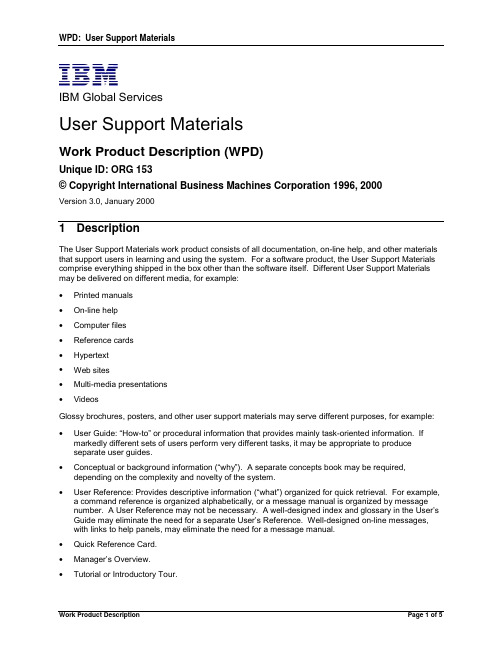
IBM Global ServicesUser Support MaterialsWork Product Description (WPD)Unique ID: ORG 153© Copyright International Business Machines Corporation 1996, 2000Version 3.0, January 20001 DescriptionThe User Support Materials work product consists of all documentation, on-line help, and other materials that support users in learning and using the system. For a software product, the User Support Materials comprise everything shipped in the box other than the software itself. Different User Support Materials may be delivered on different media, for example:• Printed manuals• On-line help• Computer files• Reference cards• Hypertext• Web sites• Multi-media presentations• VideosGlossy brochures, posters, and other user support materials may serve different purposes, for example:•User Guide: “How-to” or procedural information that provides mainly task-oriented information. If markedly different sets of users perform very different tasks, it may be appropriate to produceseparate user guides.•Conceptual or background information (“why”). A separate concepts book may be required, depending on the complexity and novelty of the system.•User Reference: Provides descriptive information (“what”) organized for quick retrieval. For example,a command reference is organized alphabetically, or a message manual is organized by messagenumber. A User Reference may not be necessary. A well-designed index and glossary in the User’s Guide may eliminate the need for a separate User’s Reference. Well-designed on-line messages, with links to help panels, may eliminate the need for a message manual.•Quick Reference Card.• Manager’s Overview.•Tutorial or Introductory Tour.• Samples.• Installation Guide.• Operations Guide.• Administrator’s Guide.Some information may appear in more than one deliverable. For example, the content of the quick reference guide will most likely come from the user guide, reference guide, or help panels. The index items or glossary terms and definitions may be used both in a hardcopy manual and in the on-line help.2 PurposeUser Support Materials help users; managers, system administrators, and others involved with the system to do their jobs. Besides using the system, these individuals must also do:•Preparation: Planning for the use and introduction of the system•Installation: Planning and instructions for site preparation, installation of the system or product and criteria for evaluating a successful install.•Administration: Managing the product and its resources to meet the needs of the organization •Operation: Starting and stopping the product (for example, the server), checking on its operation, recording its status, and reacting to abnormal events•Customization: Enhancing and extending the product•Diagnosis: Finding out the cause of system problems•Evaluation: Evaluating the product’s features, limitations, and resource requirements before deciding whether or not to buy the product2.1 Impact of Not Having This Work ProductWithout User Support Materials, people may not be able to use the system at all. At best, they will use a subset of the system and take a long time to become efficient.2.2 Reasons for Not Needing This Work ProductThere is no reason not to produce some User Support Materials. The only issues to be concerned about are how much and what kind of User Support Materials is needed.3 NotationEach part of the User Support Materials has its own structure, determined by its purpose and its delivery medium. This material usually leads the reader from general topics to more specific topics.4 ExampleRefer to the User Support Materials of a variety of software systems and products, for example:• A word processor•The IBM PROFS system• A time recording system• Lotus NotesA wide range of other products may also have interesting User Support Materials (for example, video recorders, mobile phones, and automobiles).5 Development ApproachStart building the User Support Materials as an outline then fill in the outline with more specific details. Eventually, the outline will be populated with many tasks, organized by general topics further broken down into more specific tasks.Determine what documentation to develop, and specify the content, organization, medium, and format of each. Perform the following steps:• Specify end-user documentation.−Identify each document.−Map each document to end users and tasks.−Define relationships between documents.−Develop specific objectives.−Establish design standards and guidelines.•Specify content and organization, based on specifications and detailed task analysis:−Develop table of contents, or topic list, for each document.−Define the structure of each document.−Develop the detailed outline of each document.− Select index items.−Determine cross-references or links.−Develop a list of illustrations.−Develop prototypes of selected information.•Develop the media and format specifications for each document, based on detailed task analysis, user documentation objectives, results of prototype walkthroughs, and allowable cost:−Determine media and format.−Determine the mechanism for distribution.−Determine information development environment and tools.−Establish guidelines (such as naming conventions for source files, and the use of common files and templates).−Evaluate vendors for development, publishing, and delivery.•When the outline is complete, divide it into the sections you plan to deliver. Assign one or more technical writers to each section.6 Validation and VerificationValidate this work product using the following methods:•User Support Materials should be reviewed by the technical writing staff (peer review) for editorial consistency, by the product development team for technical accuracy, and by the customer (or surrogates) for usability and completeness. The latter review might be part of the acceptance test.•Assess User Support Materials for:− Accuracy− Clarity− Readability− Retrievability− Task supportiveness•Check that each document addresses the requirement it was intended to satisfy:−Who will use it?−What will they be doing?−What environment or situation will they be in?7 Advice and GuidanceThe following guidance is suggested:•Start planning and developing User Support Materials early in the product development cycle.•Involve the technical writing staff (information developers) in the requirements phase of the project.•Review the User Support Materials outline with the customer at key customer approval checkpoints.•Analyze who will use this material and in what situation when choosing the delivery medium. For example: a vibrant but detailed product brochure could be used for marketing and customerevaluation. A planning tool (as opposed to a book) might better help a customer determine how to install and configure the product. A hypertext help tool with a CD-ROM might eliminate the need for a hardcopy user manual.8 ReferencesSome of the material for this section was derived from Information Development Guideline: Task-Oriented Information, IBM Document number ZZ27-1971-01.IBM OOTC (1997). Developing Object-Oriented Software - An Experience-Based Approach. Section 14.5, pp. 341-344. Upper Saddle River, NJ: Prentice Hall. ISBN 0-13-737248-5.9 Estimating ConsiderationsNone10 Revision HistoryDate of this release:Date of next revision:Revision Number RevisionDateSummary of Changes ChangesMarked?Version 3.0January2000MIFP published version - no changes.Version 1.2September1999A new template was applied, and the document was edited forgrammatical errors, style and content.Version 1.1February1999A standard format template was applied, and the documentwas edited for grammatical errors.Version 1.0September1998Base version.。
IBM—华为业务智能系统项目BIS系统应用统计分析流程1.0
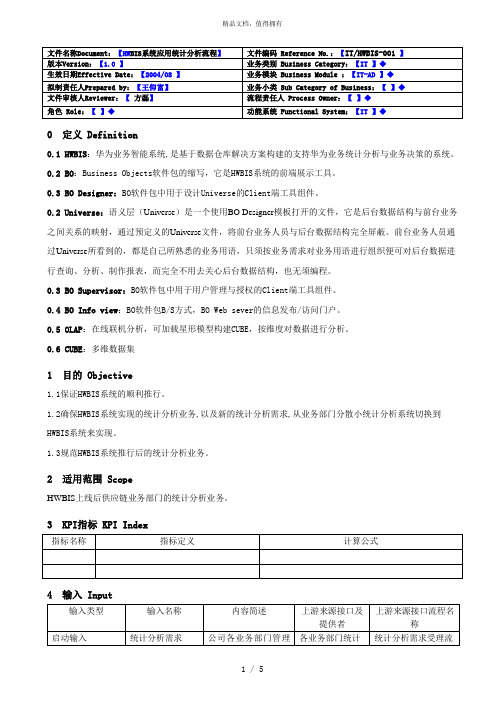
0 定义 Definition0.1 HWBIS:华为业务智能系统,是基于数据仓库解决方案构建的支持华为业务统计分析与业务决策的系统。
0.2 BO:Business Objects软件包的缩写,它是HWBIS系统的前端展示工具。
0.3 BO Designer:BO软件包中用于设计Universe的Client端工具组件。
0.2 Universe:语义层(Universe)是一个使用BO Designer模板打开的文件,它是后台数据结构与前台业务之间关系的映射,通过预定义的Universe文件,将前台业务人员与后台数据结构完全屏蔽。
前台业务人员通过Universe所看到的,都是自己所熟悉的业务用语,只须按业务需求对业务用语进行组织便可对后台数据进行查询、分析、制作报表,而完全不用去关心后台数据结构,也无须编程。
0.3 BO Supervisor:BO软件包中用于用户管理与授权的Client端工具组件。
0.4 BO Info view:BO软件包B/S方式,BO Web sever的信息发布/访问门户。
0.5 OLAP:在线联机分析,可加载星形模型构建CUBE,按维度对数据进行分析。
0.6 CUBE:多维数据集1 目的 Objective1.1保证HWBIS系统的顺利推行。
1.2确保HWBIS系统实现的统计分析业务,以及新的统计分析需求,从业务部门分散小统计分析系统切换到HWBIS系统来实现。
1.3规范HWBIS系统推行后的统计分析业务。
2 适用范围 ScopeHWBIS上线后供应链业务部门的统计分析业务。
3 KPI指标 KPI Index4 输入 Input5 输出 Output6 角色、职责及特殊技能 Roles, Responsibilities and Special Skills7 流程图 Flow Chart8 流程说明 Instructions of Process9 支持文件 Supporting Document10 相关文件 Correlative Documents11 记录的保存 Retention of Record12 补充说明 Supplementary Instructions13 文档历史 History of Document。
IBM—华为PDM项目IpdYmtE

Corporate ProductManager
• Total Product Structure • Number Assign • Product Structure Controlled BOM
HDD Mfg
Hard Disk Drive Mechanical ASM
Electrical ASM Card ASM
Electrical ASM
Information for HDD Production
Card ASM
4
Product Information Management in IBM
• Common Process, common Tools • Product Lineup early optimization • Information Sharing
• Item Reuse maximization
• Single Source (No Retype)
Product Development Process Reengineering at IBM and IPD Tools
Engineering Systems Development Information Technology Solution – IBM Japan
Agenda
Product Development and Manufacturing in IBM
Corporate PM
Item#: Lab
Assign
Information Warehousing
华为PDM概念培训教材

生命周期与工作流管理
(Lifecycle and workflow Management)
键入文本
键入文本
键入文本
键入文本
键入文本
键入文本
键入文本
产品结构管理
(Product Structure Management)
变更评估ECE
变更单ECO
变更分析活动 EAA
2022/3/22
变更活动ECA
准PDM平台,并结为伙伴
关系,被多家全球著名电
子行业公司采用
2022/3/22
7
目录
• PDM的引入 • PDM的概念和功能 • PDM的效益 • PDM实施的范围和方法
2022/3/22
8
PDM概念
“Product Data Management(PDM) is a methodology and set of tools that help an enterprise manage both product definition data and the product development process.”
2022/3/22
参考
描述于 27
产品结构管理--多视图
• 从不同使用角度去看产品结构及组成部件,得到的产品结构
• 可以从设计角度、制造角度、维护角度等获取相关视图
• 视图常使用前缀“面向(As)”,如面向设计视图(As_Designed)等
• 视图间有一定的顺序,如面向设计视图在面向计划视图前
• 视图从两个维度反映产品的变化:
3 A
33 BC
15
文档管理--内容
• 存储控制 • 版本控制 • 检索 • 权限控制 • 浏览及圈阅
华为公司研发项目管理精髓[试题]
![华为公司研发项目管理精髓[试题]](https://img.taocdn.com/s3/m/800c9fe9f605cc1755270722192e453610665ba2.png)
华为公司研发项目管理精髓华为公司在IBM咨询顾问带领下,对华为公司的产品和流程进行重整,对项目管理体系也进行了细致梳理,下面对华为公司的研发项目管理特点进行比较详细的介绍。
1、基于流程的产品开发项目管理华为公司提倡流程化的企业管理方式,任何业务活动都有明确的结构化流程来指导,如产品规划、产品开发、供应链等业务活动。
产品研发项目是企业最常见的一种项目方式,华为公司也不例外。
为了把产品研发活动管理好,华为公司建立了结构化的产品开发流程,以LPDT(产品开发项目领导)管理项目工作。
华为公司的产品开发流程分为6个阶段,分别是概念阶段、计划阶段、开发阶段、验证阶段、发布阶段、生命周期管理阶段。
为了大家了解产品开发的总体概况,华为公司首先建立了产品开发流程的袖珍卡,袖珍卡就是一个产品开发概略图,给人一个产品开发的全貌,因为可以做成象卡片一样放在口袋里随时可以拿出来学习,所以给起了名字—产品开发袖珍卡。
因为袖珍卡在指导产品开发项目团队方面还不足于具体化、可操作,所以针对袖珍卡的每个阶段又进行了展开,制作了阶段流程图,针对流程图中每项活动描述了活动含义,针对项目文档,制作了文档的模板。
按照IBM咨询顾问指导设计的产品开发流程,和原来华为公司产品开发模式进行对比,其中一项比较大的差别是:概念阶段和计划阶段明显比原来的流程周期长,更加重视概念阶段对产品的定义以及各领域策略的制定,以及重视计划阶段对技术方案的制订以及各领域实施方案的制定,后来华为公司经过几个PDT项目的验证,反而整个产品开发项目的周期缩短了。
其原因是在引入IPD之前,由于概念阶段和计划阶段时间短,产品定义模糊、方案不具体就进入了开发和验证阶段,导致开发和验证阶段周期加长,反而导致整个项目开发周期加长。
因此,华为公司的产品研发项目,是基于产品开发流程的项目管理,LPDT带领项目团队成员实施产品开发,要接照公司定义的流程来完成项目目标。
2、对产品开发项目实施端到端的管理有些企业中,由于对产品开发没有实施端到端的管理,出现了许多问题,如有个医药企业,产品开发完成了,要去销售了才发现注册工作还没有做,还有一些企业,产品开发是串行的,一个部门传递至另外一个部门,各个部门保证部门利益最大化而导致产品开发项目进度延迟。
看看华为是如何做质量管理工作的

看看华为是如何做质量管理工作的看看华为是如何做质量管理工作的华为企业一枝独秀,甚至成为了世界级的产品质量标杆,这其中的秘密是什么呢?其实也很简单,就是华为注重质量管理工作,那么到底是怎么做的呢?下面就和店铺一起来看看吧!一、跟着客户成长起来的质量体系2000年的华为,将目标锁定在IBM,要向IBM这家当时全球最大的IT企业学习管理。
当年,引入IBM公司帮助华为构建集成产品开发IPD流程(Integrated Product Development,即集成产品开发,是一套产品开发的模式、理念与方法——编者注)和集成供应链ISC体系(Internet Service Customer,即网络服务于客户,是一种最新的电子商务营销方法。
ISC也是一种Intel的服务器管理软件——编者注)。
那时,印度软件开始快速崛起,任正非认为软件的质量控制必须要向印度学习。
所以华为建立了印度研究所,将CMM软件能力成熟度模型引入华为。
IPD+CMM是华为质量管理体系建设的第一个阶段。
IPD和CMM 是全球通用的语言体系,这期间也是华为国际化业务大幅增长的时期,全球通用的语言使得客户可以理解华为的质量体系,并可以接受华为的产品与服务。
第一阶段帮助华为实现了基于流程来抓质量的过程。
在生产过程中,由于人的不同会导致产品有很大的差异,而这套体系通过严格的业务流程来保证产品的一致性。
随着华为的业务在欧洲大面积开展,新的问题出现了:欧洲国家多,运营商多,标准也多。
华为在为不同的运营商服务时,需要仔细了解每一家的标准,再将标准信息反回到国内的设计、开发、生产制造环节。
欧洲的客户认定供应商质量好不好,是有一套详细的量化指标,比如接入的速度是多少,稳定运行时间是多少,等等。
在几年前,业界有新手机发布的时候,在不同的国家都要有不同的发布时间,原因在于每个国家用户的需求不同、政府监管要求不同、行业质量标准也不同。
对于手机厂商就必须要针对不同国家做适配后再发布。
华为40亿请IBM咨询的背后故事

华为40亿请IBM咨询的背后故事导读虚⼼学习,是⼀个国家、⼀个民族、⼀个企业崛起和发展壮⼤的必经之路,也是唯⼀之路。
任正⾮斥资40亿学费向IBM虔诚拜师学艺,历时五年,这种胸怀、格局与意志⼒,在中国五千年历史中⽆疑是空前的,在世界经济发展史上也极为罕见,这正是华为之所以登上世界通讯科技巅峰的关键因素。
既然管理是制约华为从中国⼩作坊向跨国公司演变的瓶颈问题,那就要选择⼀家世界级⽼师,虔诚地拜师学艺。
1997年西⽅圣诞节前⼀周,任正⾮近距离地考察了休斯、朗讯和惠普三家世界级企业之后,将考察重点放在IBM这家最具美国特⾊的企业⾝上。
虽然圣诞节前⼣美国各⼤企业都已经放假了,但IBM包括CEO郭⼠纳在内的⾼层领导均照常上班,并真诚⽽系统地向任正⾮介绍了他们的管理内涵。
⼀、世界级⽼师让任正⾮怦然⼼动“整整⼀天时间,从产品预研到项⽬管理、从⽣产流程到项⽬寿命终结的投资评审,IBM⾼层都做了极为详尽的介绍。
为了强化任正⾮对IPD 的认识,IBM副总裁送给他⼀本哈佛⼤学出版的关于研发管理的著作,后来他发现朗讯、惠普等美国著名企业也都实施这样的研发模式。
听了⼀天的管理介绍,任正⾮对IBM这样的⼤型公司有效管理和快速反应有了新的了解,对华为本⾝存在的缺陷以及如何在扩张过程中解决管理不善、效率低下和浪费严重的问题有了新的认识,⽽对华为在未来的成长与发展过程中如何少⾛弯路,也有了新的启发和思路。
”尤其让任正⾮由衷敬佩的是,郭⼠纳作为IBM的灵魂⼈物,不仅具有罕见的坚强意志和变⾰勇⽓,⽽且为⼈处世极端低调。
正是这种务实精神,他才得以集中全部精⼒在IBM建⽴了世界⼀流的业务流程、⾼度透明的发展战略以及⾼绩效的企业⽂化,最终将IBM从死亡之⾕带到辉煌的巅峰。
这⼀切,让任正⾮怦然⼼动:华为要像IBM⼀样强⼤,不仅⾃⼰要以郭⼠纳为榜样,⽽且华为必须虔诚地拜IBM为师,不惜⼀切代价将其管理精髓移植到华为⾝上。
这是华为成为世界⼀流企业的必经之路,也唯有如此,华为才能逐步⾛向规范化、职业化和国际化。
华为、IBM、PTC的联合PDM概念培训教本资料

如开发过程中设计评审、批准、变更及产品发布等事件, 并最终落实到工作流和流程管理
2022/3/23
精品资料网
10
Windchill PDM中的对象类?
•什么叫对象类?
一个对象类是具有相同行为的对象种类;也就是说,它们有 相同的属性和功能。
精品资料网
3
目前在产品数据管理方面存在的部分问题
多个数据源,多个管理标准 低效的文档发放与查阅,文档共享性低 硬件(电子、结构)开发与软件开发通常彼此独立,导致产品集成
时重新设计
没有把硬件和软件配置作为一个系统管理,导致产品版本控制问题 对产品的更改没有进行有效跟踪和控制
• 硬件和软件更改后没有记录
项目对象 管理的基线对象 配置项目对象
2022/3/23
精品资料网
11
PDM管理企业的业务对象
• 什么叫业务对象?
可以包含和分类数据。可以有:
• 元数据 • 主要文件 • 参考文件
PDM,缩短产品开发周期、降低产品开发成本、加速新产品开发
• 在产品设计的早期运作效率越高,就会在产品中注入 更强的功能;在产品设计的关键时期优化得越好,产 品就会越成功。
ECAD
设
MCAD
计
更
改
频
PDM
度
ERP
概念
设计、开发
生产
产品开发阶段
2022/3/23
精品资料网
6
PDM选型
• 华为公司的PDM产品选择了PTC公司的Windchill系统
Windchill是第一个以web
Windchill系统功能模块
IBM—华为APS项目华为APS系统总体架构介绍

APS 系统的内部数据流
APS 系统的在华为当前的应用情况
APS系统的技术架构
- APS系统总体架构overview - APS系统的Web UI架构
- 各模块的系统架构
DP模块的系统架构 FP模块的系统架构 SCP模块的系统架构
SCC模块的系统架构
OP模块的系统架构
- 实现各模块内部集成的中间件架构 - APS系统外部集成架构 - APS系统内部集成架构 - APS系统的硬件环境
Order Promising OrPr_DF
Horizon - 6 months ATP Functionality Critical Item, Batch Order Promise
Order Planning OrPl_SCP
real time
weekly
daily
Supplier Collaboration SCC
APS系统总体架构overview
The various modules within APS architecture are as shown:
weekly
Demand Planning DP
Planning Horizon - 12 months forecast All Items, All Customers, All Geography Key Functionalities - Baseline, Consensus Forecasting, Forecast Accuracy & Reporting
SCM UI Infrastructure wM Messge Broker Task Scheduler
A P P / D A T A L A Y E R
IBM—华为PDM项目Coding Guidelines
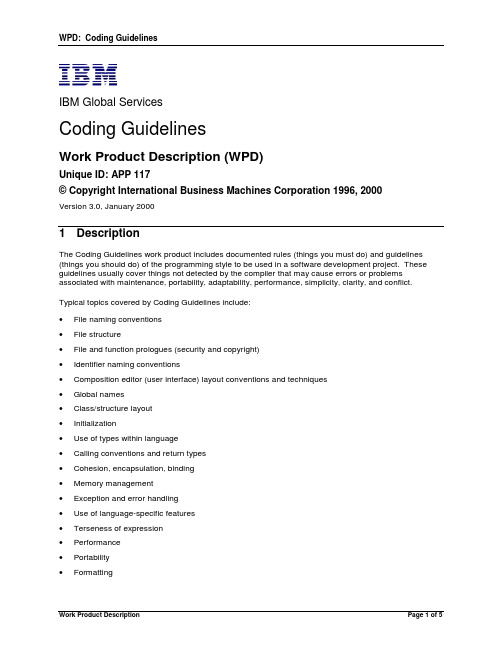
IBM Global ServicesCoding GuidelinesWork Product Description (WPD)Unique ID: APP 117© Copyright International Business Machines Corporation 1996, 2000Version 3.0, January 20001 DescriptionThe Coding Guidelines work product includes documented rules (things you must do) and guidelines (things you should do) of the programming style to be used in a software development project. These guidelines usually cover things not detected by the compiler that may cause errors or problems associated with maintenance, portability, adaptability, performance, simplicity, clarity, and conflict. Typical topics covered by Coding Guidelines include:• File naming conventions• File structure•File and function prologues (security and copyright)•Identifier naming conventions•Composition editor (user interface) layout conventions and techniques• Global names• Class/structure layout• Initialization•Use of types within language•Calling conventions and return types• Cohesion, encapsulation, binding• Memory management•Exception and error handling•Use of language-specific features•Terseness of expression• Performance• Portability• Formatting2 PurposeThe purpose of Coding style Guidelines is to outline coding conventions for the software programming process. Good Coding Guidelines play an important part in the programming process and are an important factor in quality improvement. Establishing and using sound Coding Guidelines significantly reduces common programming errors. A consistent style produces a higher quality product. A consistent user interface coding style will result in the rendering of a user interface consistent in layout and interaction (look and feel) to the end user. A common style also simplifies maintaining and debugging other people’s code.2.1 Impact of Not Having This Work ProductNot having and enforcing Coding Guidelines, will most likely accumulate inconsistent code with varying styles which leads to:•Invalid programming assumptions (runtime errors)•Difficult and costly maintenance (source code and source library)•Confusion and extended learning curve for programmers who inherit the code for maintenance, enhancement, or reuse•Inconsistency in the look and feel of the user interface.2.2 Reasons for Not Needing This Work ProductThere are no reasons for not having Coding Guidelines except when the system is a “throwaway”prototype not intended for use in actual performance of client business.3 NotationCoding Guidelines are structured (organized) into lists of guidelines grouped by topic (such as, File Naming, Identifier Naming, and Class Definitions). Each Coding Guideline should have:• A title or one line statement of the rule or guideline•An explanation of why the guideline is needed•An example showing the proper way and, optionally, the improper wayCoding Guidelines should be grouped and labeled for easy reference and perhaps summarized on one to two pages (for wall display). In the Guidelines document, each guideline definition should include:• Guideline• Reason4 ExampleSee the IBM OOTC C++ Coding Rules and Guidelines for an example of a complete set of guidelines. Here is an example from that text:Rule 11.9 Do not return a pointer or reference to local data from a function.Reason: If a reference to local data is passed back from a function, the reference will end up pointing to data that has had its storage de-allocated upon termination of the function.Exampleint& func()int i=10;return i;//i is local to func()void func2()int& number = func();number = 20; //error! The storage pointed to by number has been//deallocated. This would cause a runtime error.Note: Most new C++ compilers will produce a warning regarding this error.See VisualAge for Smalltalk UI coding guidelines (referenced below) for a complete set of user interface guidelines. Here are some examples from that text.Rule: Do not make more than three connections of any kind between any two given components. Do not make more than two connections from a part to itself.Reason: The more connections in a composition editor (CE), the harder it is to see what the code is supposed to do. Limiting the number of connections between two parts is a good start. An exception to this rule is deferred update parts and “clone” parts (see below).Rule: If you need calculated attributes to refresh when using a deferred update part, use a “clone” part.A deferred update part “catches” all attribute connections to the original part and executes them first after receiving the action “apply.” This means attributes calculated from other attributes will not update until the “apply” action is executed.Reason: The clone part is a second part with the same type as the part with the deferred update part. Every interesting attribute is copied from the original to the clone. Entry fields are connected not only to the deferred update part, but also to the clone. This allows the clone part to provide calculated attributes immediately, while the deferred update part cannot until it receives the “apply” action.Copying attributes to the clone is accomplished in one of three ways: with read-only connections from the original to the clone, with read-only connections from entry fields shared between the deferred update part and the clone, or using a script. Using a script is recommended only if the number of connections between the original and the clone exceeds ten.5 Development ApproachThe following are some recommendations for producing Coding Guidelines:•Start by using common guidelines (for example, IBM OOTC C++ Coding Rules and Guidelines) or a previous project’s guidelines, and tailor them to your needs.•Early in the project, determine high-use techniques that will benefit from consistency in their implementation.•Create specific, single instance examples to show the rest of the team how the implementation technique is to work.•Review all Coding Guidelines with the implementation team before coding begins. Make sure everyone understands and agrees to the guidelines. Make adjustments as early as possible.6 Validation and VerificationAt the start of the project, everyone who will author or review code or who has appropriate coding expertise should review the project’s intended Coding Guidelines, perhaps in a meeting. Once consensus is reached, adopt the guidelines as a starting point. The process for enforcing the guidelines (code inspections) and improving the guidelines (such as a defect prevention program, continuous quality improvement program, or informal suggestion) should also be reviewed with the team at this time. Coding Guidelines are eminently reusable from project to project. At project completion, the guidelines should be reviewed in the light of experience gained during the project.7 Advice and GuidanceWhile working on Coding Guideline, consider the following advice:•Be concise in the definition of the coding rule and its explanation.•The tailored guidelines should not duplicate what is in a textbook or existing style guide. Make sure it is truly a tailoring effort.•For improved comprehension, explain the reasoning behind each Coding Guideline and give an example of its use. If possible, describe common patterns that violate the guideline.8 ReferencesFor C++Inside IBM, a good start can be found in IBM OOTC C++ Coding Rules and Guidelines. Often projects augment these with their own local conventions. To receive a copy: request CODGUIDE from OOTC at PKEDVM9Other excellent sources of C++ Coding Guidelines are:Goldsmith, D. (1994). Taligent’s Guide to Designing Programs: Well Mannered Object-Oriented Design in C++. Addison-Wesley. ISBN 0-201-40888-0.Cline and Lomow. (1995). C++FAQS: Frequently Asked Questions. Addison-Wesley. ISBN 0-201-58958-3.Meyers, S. (1992). Effective C++: 50 Specific Ways to Improve Your Programs and Designs. Addison-Wesley. ISBN 0-201-56364-9.Meyers, S. (1996). More Effective C++: 35 New Ways to Improve Your Programs and Designs. Addison-Wesley. ISBN 0-201-63371-X.For Smalltalk:IBM Education and Training’s Object Technology University uses the Smalltalk guidelines written by Tony Colle, titled Smalltalk Programming and Development Guideline: a Manual of Style. You can request HTML or LIST3820 versions as follows:•REQUEST STMOSHTM PACKAGE FROM TONY AT DALVM1•REQUEST STMOS PACKAGE FROM TONY AT DALVM1Or you can browse it at the following URL: /assets/st-stnds.htmA very good, easy-to-follow book which provides a minimal set of guidelines to facilitate the reading and writing of Smalltalk is: Smalltalk with Style, Ed Klimas, Suzanne Skublics, David Thomas, Prentice Hall, 1995, ISBN 0-13-165549-3.Another interesting prospect is Kent Beck’s upcoming book, titled Smalltalk Best Practice Patterns. A draft copy should be available at the following URL:Norlund, C. VisualAge for Smalltalk UI Coding Style Guide. Her VM address is celeste at oslovm9 Estimating ConsiderationsFor well-established languages, buy a ‘style’ book. Allow 16 to 40 hours early in construction depending on whether there are existing guidelines or not, and the complexity and novelty of the language.10 Revision HistoryDate of this release:Date of next revision:Revision Number RevisionDateSummary of Changes ChangesMarked?Version 3.0January2000MIFP published version – no changes.Version 1.3December1999Removed context specific information from EstimatingConsiderations.NoVersion 1.2September1999Updated template, editorial changes, and inserted estimatingconsiderationsVersion 1.1February1999A standard format template was applied, and the documentwas edited for grammatical errors.Version 1.0September1998Base version.。
- 1、下载文档前请自行甄别文档内容的完整性,平台不提供额外的编辑、内容补充、找答案等附加服务。
- 2、"仅部分预览"的文档,不可在线预览部分如存在完整性等问题,可反馈申请退款(可完整预览的文档不适用该条件!)。
- 3、如文档侵犯您的权益,请联系客服反馈,我们会尽快为您处理(人工客服工作时间:9:00-18:30)。
方式:IBM 采用签署 NCO 服务协议的方式提供服务保障和进行费用结算。 8.其它有关内容
对每个 IT 项目都有完整的预算,并明确写明其回报时间。 IT 基础设施与应用系统实施项目人员要加强沟通,以保证提供足够的设施 和带宽满足系统正常运行要求。 对于新员工所需的 IT 服务,IBM 有一个严格的流程,根据部门人员增长计 划,确定 PC 机和网络计算服务需求,由当地专门的技术服务人员依照公司标准 配置好,包括给定的 IP 地址、机器名称和其它和用户使用与 IT 管理有关的信息 学,交付使用后不允许使用者更改该设置,否则被认为违反了管理制度,其服务 将不能保证。另外,IT 人员也能通过监视系统检测到该违反制度的行为。
在上述服务器安装后,NCO 组还将维护 xx 地区的下列服务器: xx 的 1 台新 notes 服务器 xx 的 1 台新 notes 服务器 yy/zz 办公室的 2 台 ADSM 服务器 xx/yy/zz 办公室的 3 台 DSM 监视服务器
在完成服务器的部署后,下列两台服务器由 MCC 组负责维护: 1 台在 MCC 的 Notes 服务器,域 h 1 台在 MCC 的 ADSM 服务器,域 I
附: IBM NCO 协议书示例和服务记分卡:
NCO 服务协议书
文档号:NCODOU9801 发行日期:1998 年四月 作者:XXX
关于这份文档 技术推广办公室已任命 NCO 对某地区从 98/01/01 到 98/12/31 提供网络计算(Network Computing Offering)相关服务。这份谅解备忘录描述了 NCO 组的责任和服务覆盖范围: NCO 新项目 日常运行支持 HelpDesk 服务 系统管理服务 报告
7.IT 成本:(变动费用部分) 部门的专项费用 ✓ 列如长途电话费,通过一段监视“语音”信息并进行记帐的小程序能获 取每个部门在语音通信方面的费用,IT 能监视整个公司的语音通信花费并 帮助把它降到合适的水平。 通用 IT 基础设施花销 ✓ 列如付给 PTT 的租线费用,也可以通过一段在技术推广部门管理下的小 程序获取所发生的费用,每个月依照协商好的付费方法付清所有使用部门 发生的费用。 花在某一业务流程的应用系统/解决方案的费用 ✓ 同样在技术推广部门管理下的小程序也可以获取特定部门使用某个应用 系统的费用。
和基础设施建设的指导性数据库,提供如下几方面的信息: ✓ 提供一个可用实际成本衡量的 IT 解决方案的部署框架 ✓ 一个合乎企业 IT 定义以保证互操作性的实施指南 ✓ 对现存系统和未来基础设施投资维持平衡的指南 ✓ 使更容易向电子化业务运作模式迁移所需的信息
再比如:建立这样一个网络规划,它对国际联接实行严格一致的标准化,并能 在集线器端进行监视,而其国内部分的联接由当地的服务提供者进行监视:
IBM 内部 IT 介绍
1.IBM 内部 IT 组织主要包括四部分:: 企业首席信息长官(CIO) 业务流程执事和业务信息执事 确保集成性的全球工作组 在地方的技术推广与方案部署人员
2.企业首席信息长官(CIO) 为 IT 方面的最高职位,在整个公司只有一位,其主要职责为: 管理整体的 IT 事务,确定预算、标准、项目优先级和提供服务的范围。 IT 基础设施总体架构和标准,包括布线和电源保障,网络(局域网,广域网), IT 硬件设备,操作系统,系统软件和语音电话系统等。 提供的服务既包括正常的运作,也包括对灾难的恢复 企业 CIO 对内部客户满意负责 列如:IBM 在一个 Notes 平台上以 WWW 共享方式提供了一个关于 IT 结yy,zzz 办公室安装 3 台 ADSM 服务器。 在 xxx 办公室安装 bbbbbbb notes 服务器,在 jjj 办公室安装 cccccc notes 服务器。 在 xxx,yyyy,zzz 办公室安装 3 台 DSM 监视器。
日常运行支持 NCO 组将继续维护 XXX 地区的下列服务器: 4 台 notes 服务器:域 a、域 b、域 c、域 d xx 办公室的 1 台 ADSM 服务器 xx 办公室的 1 台 Tivoli Courier 服务器 xx 办公室的 1 台 Netview 服务器 xx 办公室的 1 台 8260 服务器 xx/yy/zz 办公室的 3 台域控制器 xx/yy/zz 办公室的 3 台备份域控制器 xx/yy/zz 办公室的 3 台 Netfinity 服务器 xx 办公室的 1 台 AMA 服务器 xx 办公室的 1 台 DPU 服务器
务的要求 监管服务提供商保证 IT 方案实施的质量
5.确保集成性的全球工作组,其职责内容包括: 确定业务流程之间的连接和规则 信息/知识管理,包括以下方面: 数据标准和分类 新数据需求 信息仓库 应用系统架构和连通性 评价和流程设计点的一致性 兼顾自主开发方案和外购软件包的管理
6.在地方的技术推广、方案部署人员,其职责内容包括: 管理当地的在计划周期内批准的 IT 基础设施预算 在贯彻公司决策和遵循标准的前提下负责当地的 IT 基础设施规划和实施 负责当地 IT 资产的采购、保管、仓储、检测、维护以及折旧报废等事务 参与应用系统的推广工作以保证该项推广工作所需的 IT 基础设施准备停当 对所有的服务提供者的服务水准进行监控 对所有服务提供者的 IT 安全标准的一致性负责 提高内部客户的 IT 技能以更有效地利用这种高效的工具 对当地内部客户的满意度负责
✓ 一个 WEB 数据库保存了过去几个月在每个地域的国际线路利用率的数 据。
✓ 广域网的安全状态是利用率低于 60%。
3.业务流程执事 拥有一个业务流程运营的预算 可以对他或她所在的业务领域进行 IT 方面的投资并对该投资所取得的最终效
果负责
4.业务信息执事 在投资方案被批准并建立了基金后可以选择 IT 解决方案并进行实施以满足业
